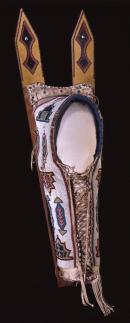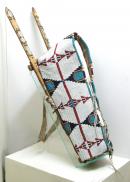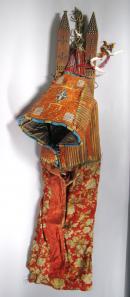The Plains region stretches from the Mississippi River west into parts of southern Canada and northern Texas, to the eastern edge of the Rocky Mountains. While the number of tribes and cradle styles is vast in this area, the MPM collection from this region is just six, representing the Iowa (2), Kiowa (1), Osage (1), and Sioux (2).
Tribes of the Southern Plains, such as the Kiowa, produced “lattice” cradles, which were often used with a V-shaped wooden frame that extended a foot or more above the top of a straight-sided carrying bag. This was lashed to the frame with hide lacings. The child was placed inside the bag and was laced from the chest to the toes. A stiffened rawhide hood was often incorporated with this cradle, which, along with the frame, protected the child’s head from injury and the elements.
Tribes in the Central Plains, including Sioux and Cheyenne, created “V” and “rectangular” hooded bags, so named because of the pattern of hood, or head covering, used in their creation. With both styles, the hood was created by a piece of hide and decorated with quill or bead decoration. The lower portion was frequently made of cloth or an additional piece of hide that was lashed around the baby. These cradles were often used without frames, and were held to the mother’s back with a blanket, or in the arms.
Eastern Plains cradles are often difficult to differentiate from Northeastern cradles. Those created by groups such as the Osage or Iowa utilized the wooden backboard and bow construction of the Northeast, with Plains geometric patterns. These were often painted or decorated with brass tacks on the top of the backboard, and the bows were frequently carved or wrapped with cloth appliqué or loom beadwork. Children were attached to the board with colorful wrappers that were usually undecorated.
One style not represented in MPM’s collection is the “inverted U-shaped” cradle of the Northwestern Plains. These cradles, created by the Ute, Crow, Arapaho, and others, had bags that were designed to not only hold the child, but also to cover the curved portion of an interior wooden frame that extended above the hood.






